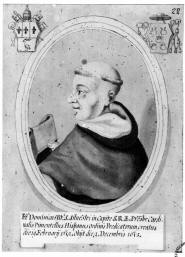Domingo Pimentel Zúñiga on:
[Wikipedia]
[Google]
[Amazon]
 Domingo Pimentel de Zúñiga O.P. (Segovia, 3 October 1585 - Rome, 2 December 1653), was a Spanish Cardinal and politician.
Domingo Pimentel de Zúñiga O.P. (Segovia, 3 October 1585 - Rome, 2 December 1653), was a Spanish Cardinal and politician.
/ref> In 1630, Philip IV appointed him to the Bishopric of Osma, which he took possession of the following year. Two years later he was promoted to the diocese of Málaga, but before occupying it he was appointed to the Bishopric of Córdoba.Catholic Hierarchy
/ref>
Before taking possession of this, he was entrusted with a diplomatic mission in which he represented the King of Spain, together with the jurist Juan Chumacero Carrillo y Sotomayor, in the negotiations between Spain and the Holy See. They dealt with issues relating to Papal rights and Royal patronage, that is, the difficult jurisdictional balance between the Papacy, local churches and the King, in fiscal, legal and even political matters within the Spanish Monarchy. At that time no agreement was reached, which was only obtained the following century in the
of 1753.
Back in Spain, in 1649 he was promoted to Archbishop of Seville. He was named Cardinal by Pope Innocent X in the consistory of 19 February 1652. He died the following year in Rome, and was buried in the church of Santa Maria sopra Minerva in that city.
 Domingo Pimentel de Zúñiga O.P. (Segovia, 3 October 1585 - Rome, 2 December 1653), was a Spanish Cardinal and politician.
Domingo Pimentel de Zúñiga O.P. (Segovia, 3 October 1585 - Rome, 2 December 1653), was a Spanish Cardinal and politician.
Biography
He was the second son ofJuan Alonso Pimentel de Herrera
Juan Alonso Pimentel de Herrera (baptisised 29 June 1553 – 7 November 1621) was a Knight of the Order of Santiago, Grandee of Spain, 5th Duke of Benavente, 8th Count of Mayorga, 3rd Count of Villalón, President of the Council of Italy, 15th ...
, Count of Benavente and his second wife Mencía de Zúñiga y Requesens. He studied at the University of Salamanca
The University of Salamanca () is a public university, public research university in Salamanca, Spain. Founded in 1218 by Alfonso IX of León, King Alfonso IX, it is the oldest university in the Hispanic world and the fourth oldest in the ...
and joined the Order of Alcántara
The Order of Alcántara ( Leonese: ''Orde de Alcántara'', ), also called the Knights of St. Julian, was originally a military order of León, founded in 1166 and confirmed by Pope Alexander III in 1177.
Alcántara
Alcántara is a town on the T ...
, of which he would be Commander of Mayorga. Having professed in the Dominican Order at the Monastery of Santa Cruz la Real
The Monastery of Santa Cruz la Real in Segovia, Spain, dates back to the 13th century. It has undergone several renovations and currently houses IE University. In 1985, UNESCO declared it a World Heritage Site.
History 13th–14th centuries
...
in Segovia
Segovia ( , , ) is a city in the autonomous communities of Spain, autonomous community of Castile and León, Spain. It is the capital and most populated municipality of the Province of Segovia. Segovia is located in the Meseta central, Inner Pl ...
, he was a teacher at the Colegio de San Gregorio
The Colegio de San Gregorio is an Isabelline style building located in the city of Valladolid, in Castile and León, Spain, it was formerly a college and now is housing the National Museum of Sculpture. This building is one of the best examples ...
in Valladolid
Valladolid ( ; ) is a Municipalities of Spain, municipality in Spain and the primary seat of government and ''de facto'' capital of the Autonomous communities of Spain, autonomous community of Castile and León. It is also the capital of the pr ...
.Real Academia de la Historia/ref> In 1630, Philip IV appointed him to the Bishopric of Osma, which he took possession of the following year. Two years later he was promoted to the diocese of Málaga, but before occupying it he was appointed to the Bishopric of Córdoba.Catholic Hierarchy
/ref>
Before taking possession of this, he was entrusted with a diplomatic mission in which he represented the King of Spain, together with the jurist Juan Chumacero Carrillo y Sotomayor, in the negotiations between Spain and the Holy See. They dealt with issues relating to Papal rights and Royal patronage, that is, the difficult jurisdictional balance between the Papacy, local churches and the King, in fiscal, legal and even political matters within the Spanish Monarchy. At that time no agreement was reached, which was only obtained the following century in the
Concordat
A concordat () is a convention between the Holy See and a sovereign state that defines the relationship between the Catholic Church and the state in matters that concern both,René Metz, ''What is Canon Law?'' (New York: Hawthorn Books, 1960
Back in Spain, in 1649 he was promoted to ...
of 1753.
Back in Spain, in 1649 he was promoted to Archbishop of Seville. He was named Cardinal by Pope Innocent X">Archbishop of Seville"> ...References
{{DEFAULTSORT:Pimentel Zúñiga, Domingo 17th-century Roman Catholic bishops in Spain 17th-century Spanish cardinals 1585 births 1653 deaths Dominican bishops 17th-century Spanish nobility 17th-century archbishops